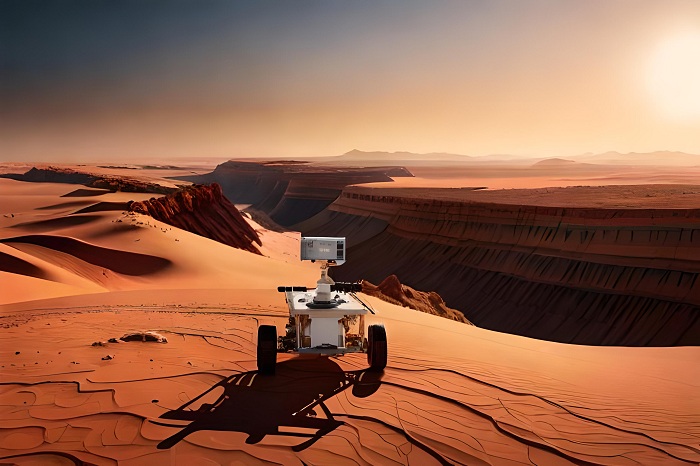Mars is a fascinating world that has intrigued scientists and explorers for centuries. One of the mysteries of Mars is the thickness and composition of its crust, the outermost layer of rock that covers the planet. The crust is important because it records the history of Mars’ geology, climate and potential habitability.
Until recently, scientists had only indirect ways of estimating the crustal thickness of Mars, such as using topographic and gravity data from orbiting spacecraft. But thanks to NASA’s InSight lander, which landed on Mars in November 2018, we now have direct measurements of seismic waves that travel through the Martian interior.
The Strongest Marsquake Ever Observed
InSight is a stationary seismometer that recorded waves rippling through Mars’ interior for four Earth years. It detected over 1,000 Marsquakes and a handful of meteorite impacts during its mission. But only two events were strong enough to send seismic waves across the entire planet and through its core.
The first event was a magnitude 4.7 quake that occurred on May 22, 2022, near the Cerberus Fossae region, a fracture zone that is a source of volcanic and tectonic activity on Mars. The quake lasted for more than six hours and was the strongest ever observed on Mars.
The second event was a meteorite impact that happened on June 15, 2022, near the Elysium Planitia region, where InSight is located. The impact created a crater about 10 meters in diameter and generated seismic waves that were similar to those from the quake.
What Seismic Waves Tell Us About Mars’ Crust
By analyzing the seismic waves from these two events, researchers were able to infer the crust thickness over the whole planet. They found that on average, the crust is between 42 and 56 kilometers thick, which is roughly 70 percent thicker than the average continental crust on Earth.
They also found that the crust is not uniform across Mars. It is thinner in the northern hemisphere, where it ranges from 32 to 44 kilometers thick, and thicker in the southern hemisphere, where it ranges from 52 to 68 kilometers thick. This difference might explain why the northern hemisphere is substantially lower in elevation than the southern one, a feature known as the Martian dichotomy.
The researchers also calculated that much of Mars’ internal heat probably originates in the crust, rather than the underlying mantle. This heat comes from radioactive elements such as potassium, uranium and thorium, which are more abundant in the crust than in the mantle. The researchers estimated that 50 to 70 percent of these elements are in the crust, which supports the idea that parts of Mars still have volcanic activity.
Implications for Mars Exploration
The new findings provide valuable insights into the structure and evolution of Mars. They help us understand how the planet formed, how it cooled and how it differentiated into layers. They also help us assess the potential for life on Mars, as the crust is where water and organic molecules might be preserved.
The findings also have implications for future Mars exploration. Knowing the crustal thickness and composition can help us choose landing sites and plan drilling operations. It can also help us interpret data from other instruments, such as radar and magnetometers, that probe the subsurface of Mars.
The InSight mission has demonstrated the power of seismology to reveal the secrets of Mars. As more seismic data become available, we can expect to learn more about the Red Planet’s heart and soul.
What’s Next for Mars Exploration?
Mars is the most explored planet in our solar system, with dozens of missions that have orbited, landed or flown by the red planet since the 1960s. But there is still much to discover about Mars, especially its potential for past or present life, its climate history and its future exploration by humans.
In 2021, three new missions arrived at Mars from different countries, each with its own scientific and technological objectives. They joined the existing fleet of orbiters and rovers that are still operating on or around Mars. And there are more missions planned for the coming years, as well as ambitious ideas for returning samples from Mars and sending humans there.
The New Arrivals
The three missions that reached Mars in February 2021 are:
- Hope, an orbiter from the United Arab Emirates, which is the first interplanetary mission from an Arab nation. Hope aims to study the Martian atmosphere and weather, and how they vary over time and space. Hope will also provide a global view of Mars and its seasons (Source: The Planetary Society).
- Tianwen-1, an orbiter, lander and rover from China, which is the first mission to attempt all three elements in one go. Tianwen-1 will orbit Mars for a few months before releasing the lander and rover, which will target a site in Utopia Planitia, a large basin in the northern hemisphere. The rover will carry six instruments to study the surface geology, soil, water ice, magnetic field and climate of Mars (Source: The Planetary Society).
- Perseverance, a rover from NASA, which is the most advanced and ambitious rover ever sent to Mars. Perseverance landed in Jezero crater, a former lake that may have hosted microbial life billions of years ago. The rover will search for signs of ancient life, collect and cache rock samples for future return to Earth, test technologies for producing oxygen from carbon dioxide, and deploy a small helicopter called Ingenuity that will attempt the first powered flight on another planet (Source: NASA).
The Ongoing Operations
The three new arrivals are not alone on Mars. There are also several orbiters and rovers that are still active and performing science and exploration tasks. They are:
- Mars Reconnaissance Orbiter (MRO), an orbiter from NASA, which has been circling Mars since 2006. MRO provides high-resolution images and data of the Martian surface, subsurface and atmosphere, as well as relays communications for other missions (Source: NASA).
- Mars Express, an orbiter from the European Space Agency (ESA), which has been orbiting Mars since 2003. Mars Express carries a suite of instruments to study the geology, mineralogy, atmosphere, climate and magnetism of Mars, as well as a radar to probe the subsurface structure and ice content (Source: ESA).
- Mars Odyssey, an orbiter from NASA, which has been orbiting Mars since 2001. Mars Odyssey carries a thermal imager, a gamma-ray spectrometer and a neutron spectrometer to map the surface composition and mineralogy of Mars, as well as measure the radiation environment (Source: NASA).
- Curiosity, a rover from NASA, which has been exploring Gale crater since 2012. Curiosity is a mobile laboratory that carries 10 instruments to analyze the rocks, soil, atmosphere and radiation of Mars, and to investigate the habitability and history of the crater (Source: NASA).
- InSight, a lander from NASA, which has been stationed in Elysium Planitia since 2018. InSight is a geophysical station that carries a seismometer, a heat probe and a radio experiment to study the interior structure, heat flow and rotation of Mars (Source: NASA).
The Future Plans
The exploration of Mars is not over yet. There are more missions in the pipeline that will launch in the next few years, as well as long-term visions for bringing back samples from Mars and sending humans there. Some of the upcoming missions are:
- ExoMars, a rover and surface platform from ESA and Roscosmos, which has been delayed until 2024 due to technical issues. ExoMars will land in Oxia Planum, a region that may have been habitable in the past. The rover will carry a drill to collect samples from up to two meters below the surface, and a suite of instruments to search for signs of life and study the environment (Source: ESA).
- Mars Orbiter Mission 2 (MOM 2), an orbiter from India, which is planned to launch in 2024. MOM 2 will be a follow-up to India’s first Mars mission, MOM 1 or Mangalyaan, which launched in 2013 and is still operational. MOM 2 will carry more advanced instruments to study the Martian surface, atmosphere and exosphere (Source: ISRO).
- Mars Sample Return (MSR), a joint project from NASA and ESA, which aims to bring back the samples collected by Perseverance rover to Earth by 2031. MSR will involve several missions, including an orbiter, a lander, a fetch rover and a return vehicle. The samples will be launched into orbit by the return vehicle, captured by the orbiter and transferred to an Earth entry capsule that will land safely on Earth. The samples will then be analyzed in specialized laboratories for signs of life and other scientific questions (Source: NASA).
- Human Mars Exploration, a long-term goal of several space agencies and private companies, which envisions sending humans to Mars in the next few decades. Human Mars exploration will require overcoming many challenges, such as developing reliable transportation systems, ensuring crew health and safety, providing adequate resources and infrastructure, and conducting meaningful scientific and exploration activities. Human Mars exploration will also require sustained public support and international cooperation (Source: NASA).
Conclusion
Mars is a fascinating world that has intrigued scientists and explorers for centuries. The exploration of Mars is not over yet. There are many new missions that have arrived or will arrive at Mars in the next few years, each with its own scientific and technological objectives. There are also ambitious ideas for returning samples from Mars and sending humans there. Mars exploration will continue to reveal the secrets of the red planet and inspire future generations of explorers.




